
The 82nd Airborne Division is an airborne infantry division of the United States Army specializing in parachute assault operations into denied areas with a U.S. Department of Defense requirement to "respond to crisis contingencies anywhere in the world within 18 hours". Based at Fort Bragg, North Carolina, the 82nd Airborne Division is part of the XVIII Airborne Corps. The 82nd Airborne Division is the U.S. Army's most strategically mobile division. More recently, the 82nd Airborne has been conducting operations in Iraq, advising and assisting Iraqi Security Forces.
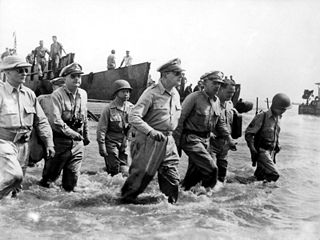
The Battle of Leyte in the Pacific campaign of World War II was the amphibious invasion of the island of Leyte in the Philippines by American forces and Filipino guerrillas under the overall command of General Douglas MacArthur, who fought against the Imperial Japanese Army in the Philippines led by General Tomoyuki Yamashita. The operation, codenamed King Two, launched the Philippines campaign of 1944–45 for the recapture and liberation of the entire Philippine Archipelago and to end almost three years of Japanese occupation.

The Eighth Army is a U.S. field army which is the commanding formation of all United States Army forces in South Korea. It commands U.S. and South Korean units and is headquartered at the Camp Humphreys, in the Anjeong-ri of Pyeongtaek, South Korea. It is the only field army in the U.S. Army.
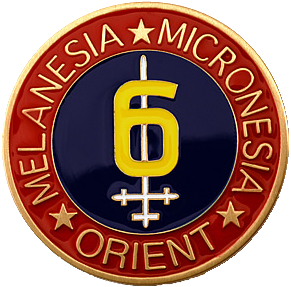
The 6th Marine Division was a United States Marine Corps World War II infantry division formed in September 1944. During the invasion of Okinawa it saw combat at Yae-Take and Sugar Loaf Hill and was awarded a Presidential Unit Citation. The 6th Division had also prepared for the invasion of Japan before the war ended. After the war it served in Tsingtao, China where the division was disbanded on April 1, 1946, being the only Marine division to be formed and disbanded overseas and never set foot in the United States.

The Philippines campaign, also known as the Battle of the Philippines or the Fall of the Philippines, was from December 8, 1941 to May 8, 1942 the invasion of the Philippines by the Empire of Japan and the defense of the islands by United States and the Philippine Armies during World War II.

This is the complete order of battle of Allied and Japanese forces during the Borneo campaign of 1945. As the campaign was fought in three geographically separate areas and the same air and naval units supported more than one of these battles the order of battle is split into the three areas.
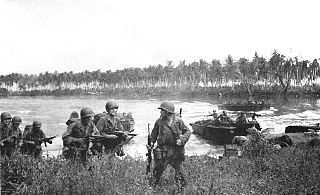
The Admiralty Islands campaign was a series of battles in the New Guinea campaign of World War II in which the United States Army's 1st Cavalry Division took the Japanese-held Admiralty Islands.
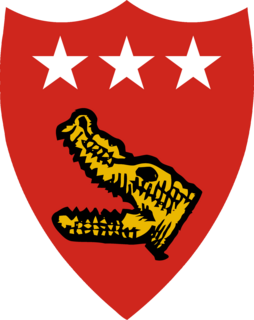
The V Amphibious Corps (VAC) was a formation of the United States Marine Corps which was composed of the 3rd, 4th and 5th Marine Divisions in World War II. The three divisions were the amphibious landing force for the United States Fifth Fleet with two goals, removal of Japanese forces from islands so U.S. Seabees could build advance bases to project US power. In doing this VAC was notably involved in the battles for Tarawa, Saipan, and Iwo Jima. V Amphibious Corps was commanded by General Holland 'Howlin Mad' Smith followed by General Harry Schmidt.

The Battle of Morotai, part of the Pacific War, began on 15 September 1944, and continued until the end of the war in August 1945. The fighting started when United States and Australian forces landed on the southwest corner of Morotai, a small island in the Netherlands East Indies (NEI), which the Allies needed as a base to support the liberation of the Philippines later that year. The invading forces greatly outnumbered the island's Japanese defenders and secured their objectives in two weeks. Japanese reinforcements landed on the island between September and November, but lacked the supplies needed to effectively attack the Allied defensive perimeter. Intermittent fighting continued until the end of the war, with the Japanese troops suffering heavy loss of life from disease and starvation.

Camp Edwards is a United States military training installation which is located in western Cape Cod in Barnstable County, Massachusetts. Originally the Massachusetts Military Reservation acquired in September 1935, in 1938 it was named after Major General Clarence Edwards, commander of the 26th Division in World War I. It is home to the 3rd Battalion, 126th Aviation Regiment.

The landing at Saidor, codenamed Operation Michaelmas, was an Allied amphibious landing at Saidor, Papua New Guinea on 2 January 1944 as part of Operation Dexterity during World War II. In Allied hands, Saidor was a stepping stone towards Madang, the ultimate objective of General Douglas MacArthur's Huon Peninsula campaign. The capture of the airstrip at Saidor also allowed construction of an airbase to assist Allied air forces to conduct operations against Japanese bases at Wewak and Hollandia. But MacArthur's immediate objective was to cut off the 6,000 Imperial Japanese troops retreating from Sio in the face of the Australian advance from Finschhafen.
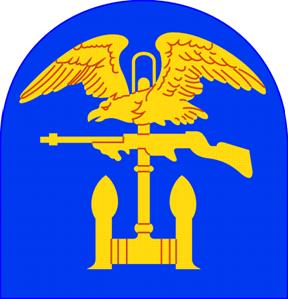
Engineer Special Brigades were amphibious forces of the United States Army developed during World War II. Initially designated engineer amphibian brigades, they were redesignated engineer special brigades in 1943. The 1st, 5th, and 6th Engineer Special Brigades were assigned to the European Theater of Operations. The 1st Engineer Special Brigade participated in the landings in Sicily and Italy before joining the 5th and 6th Engineer Special Brigades for the invasion of Normandy.

The Battle of Sio, fought between December 1943 and March 1944, was the break-out and pursuit phase of General Douglas MacArthur's Huon Peninsula campaign, part of the New Guinea campaign of World War II.

Daniel Noce (1894−1976) was a U.S. Army Lieutenant General who served in both world wars.
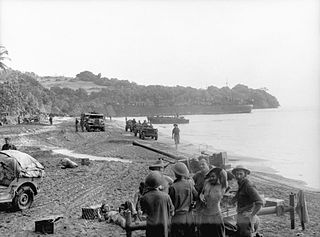
The Landing at Scarlet Beach took place in New Guinea during the Huon Peninsula campaign of the Second World War, involving forces from Australia, the United States and Japan. Allied forces landed at Scarlet Beach, north of Siki Cove and south of the Song River, to the east of Katika and about 10 kilometres (6.2 mi) north of Finschhafen. The capture of Finschhafen allowed the construction of air base and naval facilities to assist Allied air and naval forces to conduct operations against Japanese bases in New Guinea and New Britain.

The Battle of Finschhafen was part of the Huon Peninsula campaign in New Guinea during World War II and was fought between Australian and Japanese forces. The fighting took place between 22 September and 24 October 1943 following the landing at Scarlet Beach, which was followed by a two-pronged advance on Finschhafen as the Australian 20th Infantry Brigade advanced on the town from the north, while the 22nd Infantry Battalion drove from the south, having advanced from the landing beaches east of Lae. After the capture of Finschhafen, the Japanese forces in the area withdrew towards Sattelberg where they sought to hold the Australians before launching a counteroffensive, which subsequently threatened the landing beach. This attack was repelled by American and Australian forces, with heavy casualties being inflicted on the Japanese. In the aftermath, the Australians went on the offensive, capturing Sattelberg, and then advancing towards the Wareo plateau.
The 594th Boat and Shore Regiment was a military engineer unit in the United States Army. The regiment served during World War II and was also known as the 594th Engineer Amphibian Regiment.
The Landing on Long Island in the Territory of New Guinea was part of the Huon Peninsula campaign, a series of operations that made up Operation Cartwheel, General Douglas MacArthur's campaign to encircle the major Japanese base at Rabaul. Located at the northern end of the Vitiaz Strait, Long Island was an important staging point for Japanese barges moving between Rabaul and Wewak until 26 December 1943, when a force of 220 Australian and American soldiers landed on the island. It was not occupied by the Japanese at the time, and there was no fighting. At the time, it represented the furthest Allied advance into Japanese-held territory. It was developed into a radar station.

The 1st Engineer Brigade is a military engineering training brigade of the United States Army subordinate to the United States Army Engineer School. It is headquartered at Fort Leonard Wood, Missouri.

The 2nd Engineer Brigade was a military engineering brigade of the United States Army, that was subordinate to United States Army Alaska and had its headquarters at Fort Richardson, Alaska, prior to deactivation in 2015.
















